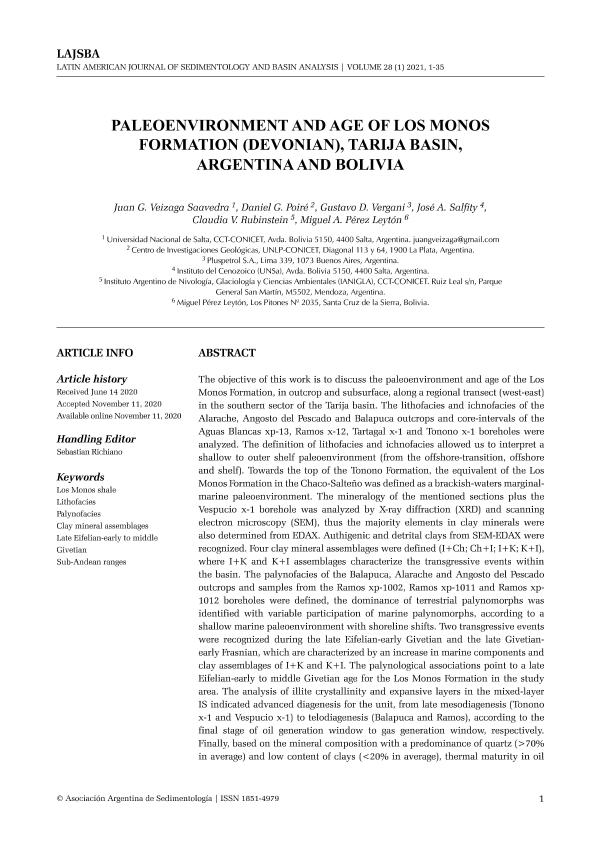Mostrar el registro sencillo del ítem
dc.contributor.author
Veizaga Saavedra, Juan Gonzalo

dc.contributor.author
Poiré, Daniel G.
dc.contributor.author
Vergani, Gustavo Dardo

dc.contributor.author
Salfity, Jose Antonio

dc.contributor.author
Rubinstein, Claudia Viviana

dc.contributor.author
Pérez Leytón, Miguel A.
dc.date.available
2021-09-24T12:02:52Z
dc.date.issued
2020-11
dc.identifier.citation
Veizaga Saavedra, Juan Gonzalo; Poiré, Daniel G.; Vergani, Gustavo Dardo; Salfity, Jose Antonio; Rubinstein, Claudia Viviana; et al.; Paleoenvironment and age of Los Monos Formation (Devonian), Tarija Basin, Argentina and Bolivia; Asociación Argentina de Sedimentología; Latin American Journal of Sedimentology and Basin Analysis; 28; 1; 11-2020; 1-35
dc.identifier.issn
1851-4979
dc.identifier.uri
http://hdl.handle.net/11336/141434
dc.description.abstract
The objective of this work is to discuss the paleoenvironment and age of the Los Monos Formation, in outcrop and subsurface, along a regional transect (west-east) in the southern sector of the Tarija basin. The lithofacies and ichnofacies of the Alarache, Angosto del Pescado and Balapuca outcrops and core-intervals of the Aguas Blancas xp-13, Ramos x-12, Tartagal x-1 and Tonono x-1 boreholes were analyzed. The definition of lithofacies and ichnofacies allowed us to interpret a shallow to deep marine paleoenvironment (from the offshore-transition, offshore and shelf). Towards the top of the Tonono Formation, the equivalent of the Los Monos Formation in the Chaco-Salteño was defined as a brackish-waters marginal-marine paleoenvironment. The mineralogy of the mentioned sections plus the Vespucio x-1 borehole was analyzed by X-ray diffraction (XRD) and scanning electron microscopy (SEM), thus the majority elements in clay minerals were also determined from EDAX. Authigenic and detrital clays from SEM-EDAX were recognized. Four clay mineral assemblages were defined (I+Ch; Ch+I; I+K; K+I), where I+K and K+I assemblages characterize the transgressive events within the basin. The palynofacies of the Balapuca, Alarache and Angosto del Pescado outcrops and samples from the Ramos xp-1002, Ramos xp-1011 and Ramos xp-1012 boreholes were defined, the dominance of terrestrial palynomorphs was recognized with variable participation of marine palynomorphs, according to a shallow marine paleoenvironment with shoreline shifts. Two transgressive events were identified during the late Eifelian-early Givetian and the late Givetian-early Frasnian, which are characterized by an increase in marine components and clay assemblages of I+K and K+I. The palynological associations pont to a late Eifelian-early to middle Givetian age for the Los Monos Formation in the study area. The analysis of illite crystallinity and expansive layers in the mixed-layer IS determined advanced diagenesis for the unit, from late mesodiagenesis (Tonono x-1 and Vespucio x-1) to telodiagenesis (Balapuca and Ramos), according to the final stage of oil generation window to gas generation window, respectively. Finally, based on the mineral composition with a predominance of quartz (>70% in average) and low content of clays (<20% in average), thermal maturity in oil and gas window, the important thickness in the subsurface (700-1000 meters) and significant lateral continuity (>100 km2), the unit has some of the attributes to be considered as a shale-type unconventional reservoir.
dc.format
application/pdf
dc.language.iso
eng
dc.publisher
Asociación Argentina de Sedimentología
dc.rights
info:eu-repo/semantics/openAccess
dc.rights.uri
https://creativecommons.org/licenses/by-nc/2.5/ar/
dc.subject
LOS MONOS SHALE
dc.subject
LITHOFACIES
dc.subject
PALYNOFACIES
dc.subject
CLAY MINERAL ASSEMBLAGES
dc.subject
MIDDLE DEVONIAN
dc.subject
SUB-ANDEAN RANGES
dc.subject.classification
Geociencias multidisciplinaria

dc.subject.classification
Ciencias de la Tierra y relacionadas con el Medio Ambiente

dc.subject.classification
CIENCIAS NATURALES Y EXACTAS

dc.title
Paleoenvironment and age of Los Monos Formation (Devonian), Tarija Basin, Argentina and Bolivia
dc.type
info:eu-repo/semantics/article
dc.type
info:ar-repo/semantics/artículo
dc.type
info:eu-repo/semantics/publishedVersion
dc.date.updated
2021-09-06T19:55:56Z
dc.journal.volume
28
dc.journal.number
1
dc.journal.pagination
1-35
dc.journal.pais
Argentina

dc.journal.ciudad
Buenos Aires
dc.description.fil
Fil: Veizaga Saavedra, Juan Gonzalo. Universidad Nacional de Salta. Facultad de Ciencias Naturales; Argentina. Consejo Nacional de Investigaciones Científicas y Técnicas; Argentina
dc.description.fil
Fil: Poiré, Daniel G.. Comision de Investigaciones Cientificas de la Provincia de Buenos Aires. Centro de Geologia Aplicada, Agua y Medio Ambiente.; Argentina
dc.description.fil
Fil: Vergani, Gustavo Dardo. No especifíca;
dc.description.fil
Fil: Salfity, Jose Antonio. Universidad Nacional de Salta. Facultad de Ciencias Naturales. Instituto del Cenozoico; Argentina. Consejo Nacional de Investigaciones Científicas y Técnicas; Argentina
dc.description.fil
Fil: Rubinstein, Claudia Viviana. Consejo Nacional de Investigaciones Científicas y Técnicas. Centro Científico Tecnológico Conicet - Mendoza. Instituto Argentino de Nivología, Glaciología y Ciencias Ambientales. Provincia de Mendoza. Instituto Argentino de Nivología, Glaciología y Ciencias Ambientales. Universidad Nacional de Cuyo. Instituto Argentino de Nivología, Glaciología y Ciencias Ambientales; Argentina
dc.description.fil
Fil: Pérez Leytón, Miguel A.. No especifíca;
dc.journal.title
Latin American Journal of Sedimentology and Basin Analysis
dc.relation.alternativeid
info:eu-repo/semantics/altIdentifier/url/https://lajsba.sedimentologia.org.ar/index.php/lajsba/article/view/48
Archivos asociados
